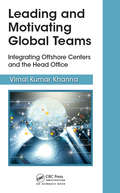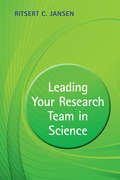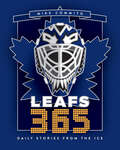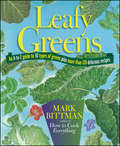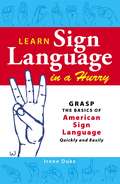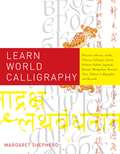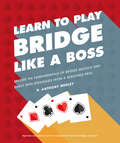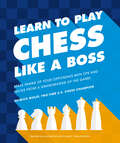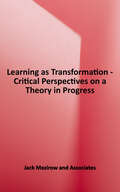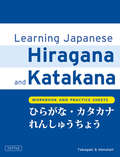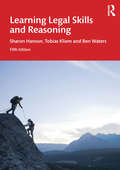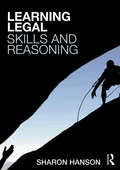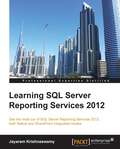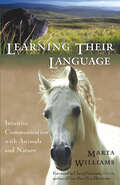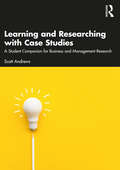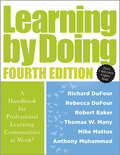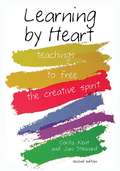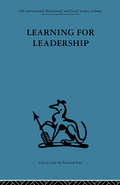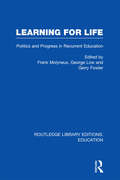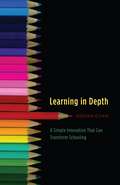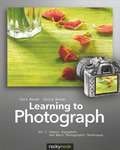- Table View
- List View
Leading and Motivating Global Teams: Integrating Offshore Centers and the Head Office (Best Practices in Portfolio, Program, and Project Management)
by Vimal Kumar KhannaThis book provides techniques for offshore center managers and head office managers to motivate and manage globally distributed teams, which are spread across the offshore center and the head office, and thereby achieve higher productivity. Readers learn how to integrate the offshore center with the head office to make the offshore team an extension of the head office. While integrating teams with the head office, offshore center managers can still retain independence and authority to meet team aspirations. <P><P>The book provides insight into devising new organizational structures to balance the authority and responsibilities of offshore center and head office managers. Head office managers responsible for managing globally distributed projects learn how to achieve a higher success rate on their projects and be better rewarded for their efforts in offshoring. Head office managers also learn techniques to make more significant contributions in their expatriate assignments to the offshore center. <P><P>This book guides both the offshore center managers and the head office managers to fully realize the potential of the offshore center, which can result in higher revenues and profitability.
Leading and Motivating Global Teams: Integrating Offshore Centers and the Head Office (Best Practices in Portfolio, Program, and Project Management)
by Vimal Kumar KhannaThis book provides techniques for offshore center managers and head office managers to motivate and manage globally distributed teams, which are spread across the offshore center and the head office, and thereby achieve higher productivity. Readers learn how to integrate the offshore center with the head office to make the offshore team an extension of the head office. While integrating teams with the head office, offshore center managers can still retain independence and authority to meet team aspirations. The book provides insight into devising new organizational structures to balance the authority and responsibilities of offshore center and head office managers. Head office managers responsible for managing globally distributed projects learn how to achieve a higher success rate on their projects and be better rewarded for their efforts in offshoring. Head office managers also learn techniques to make more significant contributions in their expatriate assignments to the offshore center. This book guides both the offshore center managers and the head office managers to fully realize the potential of the offshore center, which can result in higher revenues and profitability.
Leading your Research Team in Science
by Ritsert C. JansenTeam leaders should be full of ideas for new research projects and inspire a research group to achieve great results. This practical guide for team leaders, and those who aspire to become team leader, offers a unique approach to help readers develop research and become a more independent and productive investigator. Readers can learn how to recruit and develop talented team members, how to negotiate contracts and manage projects, and how to create wider visibility and publicity for their science. From human resources and project finances, legal affairs and knowledge transfer to public engagement and media performance, the book provides guidance to enhance skills and combine them with those of support staff on the road to success. With numerous valuable tips, real-life stories and practical exercises, this must-read guide provides everything needed to take responsibility for leading research teams. This title is available as Open Access via Cambridge Core.
Leafs 365: Daily Stories from the Ice (Hockey 365 #3)
by Mike CommitoNow you can cheer for the Toronto Maple Leafs every day of the year, even when they’re out of the NHL playoffs.Get your daily Toronto Maple Leafs fix with Leafs 365. From the franchise’s early beginning as the Arenas and the St. Patricks to the incredible four-goal comeback against the Lightning in the 2023 Stanley Cup Playoffs, Leafs 365 includes 365 short stories about everybody’s favourite hockey team — one for every day of the year — to remind you why you still cheer for the blue and white season after season. Some people say that the Leafs are cursed, but any team that brings you this many moments worth revisiting must be blessed. You may not be old enough to remember the team’s last Stanley Cup, but chances are you can recall Auston Matthews’s four-goal debut or the sense of optimism when the Leafs signed John Tavares. And while there are plenty of stories in this book that might make you question why you still root for the Buds, like the Game 7 meltdown to the Bruins in 2013 or losing to the Hurricanes, who had a Zamboni driver in net in 2020, the lowlights are what make the best times sweeter and worth celebrating. Chances are, if you’re holding this book in your hands, you’re a Leafs fan, and with every turn of the page you’ll fall in love with them all over again.
Leafs AbomiNation: The dismayed fan's handbook to why the Leafs stink and how they can rise again
by Dave Feschuk Michael GrangeLove them or hate them, they're the most successful team in professional hockey ... just not on the scoresheet.The Toronto Maple Leafs are an exception to every law of the sporting jungle. They miss the playoffs and the sellouts keep coming. They haven't won a Stanley Cup since 1967, but the earning power of that blue-and-white maple leaf, no matter the chronic woes of the blue-and-white's power play, never ceases to increase. In this description of failure and prescription for hope, Toronto Star sports columnist Dave Feschuk and Globe and Mail sports reporter Michael Grange draw the illogical roadmap that pinpoints how the once-proud Leafs got lost in the sporting hinterlands, who's to blame for stranding them there, and how they might extract themselves from this historic mire.From the Trade Paperback edition.
Leafy Greens: An A-to-Z Guide to 30 Types of Greens Plus More than 120 Delicious Recipes
by Mark BittmanThe handy, healthy reference and cookbook from the James Beard Award-winning author of How to Cook Everything—now with a new introduction. Kale and collards. Radicchio. Chinese cabbage. Swiss chard. Mustard greens. Broccoli raab. Arugula. Belgian endive. Greens are among our most delicious, nutritious, and versatile vegetables. All of us know we should be cooking with them, but few of us know how. In his classic Leafy Greens, bestselling author Mark Bittman shares what he knows about more than 30 common kinds of greens so you can start using them in satisfying salads, sides, and main courses every day. Bittman will help you learn where and when to purchase them, why they&’re good for you, and how to cook them in more than 120 delicious, healthy ways. And with his easy-to-use A-to-Z format and single-page recipes, Leafy Greens packs as much information into one book as there are micro-nutrients in a bunch of kale. Try delicious recipes like:Grilled Chicken Salad with MesclunGingered CabbageCoconut Curry Soup with ChardRisotto with Arugula and ShrimpHamburgers with Spinach and ParmesanBaked Penne with Radicchio and GorgonzolaCorn and Kale Stew, and many more
Learn Sign Language in a Hurry: Grasp the Basics of American Sign Language Quickly and Easily
by Irene Duke"I love you.""What can I get you?""Let's take a walk."Wanting to say simple things like these but not being able to is frustrating and disheartening-but learning how to communicate can be easy and fun! This book is a basic guide to the alphabet, vocabulary, and techniques it takes to connect using American Sign Language. Whether signing out of necessity or learning for the sake of growing, you will enjoy this practical primer. After reading this book, you will be able to use American Sign Language in a social, educational, or professional setting.Whether the goal is to communicate with hearing-impaired grandparent, a child with special needs in school, or an infant, people learn sign language for many different reasons. Easy to read and reference-and complete with images and examples of common signs-this basic guide allows you to make a meaningful connection that's otherwise impossible.
Learn World Calligraphy: Discover African, Arabic, Chinese, Ethiopic, Greek, Hebrew, Indian, Japanese, Korean, Mongolian, Russian, Thai, Tibetan Calligraphy, and Beyond
by Margaret ShepherdLearn World Calligraphy has something for everyone. Whether you want scholarly insight, artistic inspiration, classroom projects, or a theme for your next party, this comprehensive, unparalleled full-color book will guide you on a virtual trip around the globe. Covering nearly all of the world's writing systems--from African to Arabic, Chinese to Greek, Hebrew to Russian, and beyond--Learn World Calligraphy offers a unique glimpse of scripts worldwide and the calligraphers who write them.Lushly illustrated with gorgeous examples of both historical and modern calligraphic designs, this book is filled with practical instruction for how key aspects of each exotic script can be applied to the English alphabet, generating calligraphic hybrids with a distinctly foreign flair. Like a new cuisine that you can't wait to cook at home, the scripts you meet in this book are sure to infuse your own calligraphy with the flavor of abroad. Bon voyage!
Learn to Knit, Love to Knit
by Anna WilkinsonYoung designer Anna Wilkinson offers the cutest patterns ever for garments and accessories, plus comprehensive tutorials for beginners and intermediate knitters alike.Colorful, fun, and utterly adorable, Anna Wilkinson's designs appeal to beginner knitters who haven't been inspired by typical beginner projects. These 20 patterns in her first book are flattering to women of all shapes, exceptionally easy to wear, and surprisingly easy to knit. Learn to Knit, Love to Knit teaches the basics of the craft with clear, step-by-step photos and tips to guide knitting newbies through the fundamentals. The 10 basic "Learn to Knit" projects include a color-block scarf, quick-to-knit hats, and mix-and-match wrist-warmers in a rainbow of colors. The following 10 "Love to Knit" designs introduce more advanced techniques, including cables, slip-stitch patterns, and color work. Including a tweed cape, classic cardigans, and a tartan sweater, these unique pieces will inspire beginners to pick up a pair of needles and fall in love with knitting.
Learn to Play Bridge Like a Boss: Master the Fundamentals of Bridge Quickly and Easily with Strategies From a Seas (Learn to Play)
by H. Anthony MedleyPlay like a pro with expert knowledge from a champion of the gameIf you don't know the ins and outs of play, bridge can seem like an intimidating game--but it doesn't have to be! Armed with the techniques and strategies in the pages of this book, you'll be bidding and winning hands like a boss!Follow the guidance and knowledge of a pro as he takes you through the basics of the game. You'll get lessons on making opening bids, evaluating your hand, responding to your partner's bid, rebidding, and overcalling--and even a bonus tear-out sheet to take your new strategies on the go!
Learn to Play Chess Like a Boss: Make Pawns of Your Opponents with Tips and Tricks From a Grandmaster of the Game (Learn to Play)
by Patrick WolffStop playing like a pawn and start playing like the kingYou already know just how enjoyable--and and challenging--the game of chess can be. For those who play, chess leads to a lifetime of fun. But how do you make the first move to learn the rules and transform from a pawn to a king?The path to a perfect checkmate is in your hands! In the pages of this book, you'll find an introduction to all the chess pieces including their strengths and weaknesses, tips on how to protect your pieces and prevent their capture, and guidance on when to attack and defend like a boss. You'll also find a bonus tear-out card to take your new tactics on the go!
Learning As Transformation: Critical Perspectives on a Theory in Progress, 1st Edition
by Jack MezirowProvocative and illuminating, this book is a must-read for adult educators seeking to understand and facilitate transformational learning. It showcases a stellar group of authors who not only engage each other and the reader in constructive discourse, but who also model the heart of the transformational learning process." --Sharan B. Merriam, Department of Adult Education, University of Georgia This volume continues the landmark work begun by Jack Mezirow over twenty years ago--revealing the impact of transformative learning on the theory and practice of adult education. Top scholars and practitioners review the core principles of transformation theory, analyze the process of transformative learning, describe different types of learning and learners, suggest key conditions for socially responsible learning, explore group and organizational learning, and present revelations from the latest research. They also share real-world examples drawn from their own experiences and assess the evolution of transformative learning in practice and philosophy. Learning as Transformation presents an intimate portrait of a powerful learning concept and invites educators, researchers, and scholars to consider the implications of transformative learning in their professional work.
Learning Japanese Hiragana and Katakana
by Kenneth Henshall Tetsuo TakagakiLearning Hiragana and Katakana is a systematic and comprehensive workbook that can be used along with a Japanese language textbook or as a stand-alone resource to learn the Japanese alphabet (kana).Japanese has 3 writing systems, all used together: hiragana, katakana and kanji. Learning Japanese Hiragana & Katakana helps newcomers learn how to use the first two systems' basic 92 characters to read, write and communicate. With expanded writing and preparation space, this revised edition offers ample provisions for practice, review and self-testing at several levels. It also includes a detailed reference section explaining the origin and function of kana and the various kana combinations. Complete with a detailed pronunciation guide, this volume will prove invaluable for beginning students or those accustomed to romanized Japanese (romanji). This workbook is a perfect companion to Tuttle Publishing's Japanese Hiragana & Katakana for Beginners or any other Japanese textbook on the market.This workbook includes:Systematic and comprehensive coverage of the two kana systemsAmple provision for kana practice, review, and self-testing at several levelsDetailed reference section explaining the origin and function of kana, and the various kana combinationsHelpful additional information for language students accustomed to romanized JapaneseJapanese pronunciation guidance for all basic soundsVocabulary selected for usefulness and cultural relevance
Learning Legal Skills and Reasoning
by Sharon Hanson Tobias Kliem Ben WatersLanguage skills, study skills, argument skills and the skills associated with dispute resolution are vital to every law student, professional lawyer and academic. The 5th edition of Learning Legal Skills and Reasoning draws on a range of areas of law to show how these key skills can be learnt and mastered, bridging the gap between substantive legal subjects and the skills required to become a successful law student. The book is split into four sections: Sources of law: Including domestic, European and international law. Working with the law: Featuring advice on how to find and understand the most appropriate legislation and cases. Applying your research: How to construct a legal argument, answer a problem question and present orally (mooting). Skills for solving disputes: From negotiation to mediation and beyond. Packed full of practical examples and diagrams to illustrate each legal skill, this new edition has been fully updated and now includes a new chapter on drafting. It will be an essential companion for any student wishing to acquire the legal skills necessary to become a successful law student.
Learning Legal Skills and Reasoning
by Sharon HansonLanguage skills, study skills, argument skills and legal knowledge are vital to every law student, professional lawyer and academic. Learning Legal Skills and Reasoning discusses the main sources of English law and explains how to work with legal texts in order to construct credible legal arguments which can be applied in coursework, exams or presentations. Learning Legal Skills and Reasoning Discusses how to find and understand sources of both domestic and European Union Law Develops effective disciplined study techniques, including referencing, general reading, writing and oral skills and explains how to make good use of the university print and e-library Contains chapters on writing law essays, problem questions and examinations, and on oral skills including presentations and mediation skills Packed full of practical examples and diagrams across the range of legal skills from language and research skills to mooting and negotiation, this textbook will be invaluable to law students seeking to acquire a range of discreet legal skills in order to use them together to produce competent assessed work.
Learning SQL Server Reporting Services 2012
by Jayaram KrishnaswamyThe book is packed with clear instructions and plenty of screenshots, providing all the support and guidance you will need as you begin to generate reports with SQL Server 2012 Reporting Services.This book is for those who are new to SQL Server Reporting Services 2012 and aspiring to create and deploy cutting edge reports. This book is for report developers, report authors, ad-hoc report authors and model developers, and Report Server and SharePoint Server Integrated Report Server administrators. Minimal knowledge of SQL Server is assumed and SharePoint experience would be helpful.
Learning Their Language: Intuitive Communication with Animals and Nature
by Marta WilliamsAlmost everyone has had a moment when they've felt a connection to an animal. Animal communicator Marta Williams says this is the basis of animal communication and it's a skill anyone can develop. Williams's background as a scientist informs her logical step-by-step approach to learning the "language" of animals — a process combining mental imagery, visualization, deep listening, and tuning in to one's intuition. Practical advice and proven techniques are interwoven with inspiring real-life accounts. Williams also discusses ways to use these skills to find lost animals, help animals heal from injury or illness, and explore similar deep connections with nature and the earth.
Learning and Researching with Case Studies: A Student Companion for Business and Management Research
by Scott AndrewsThis companion takes the student through the different approaches to working with cases in the classroom, virtually and for research purposes. Capturing insights and best practices shared by scholars of the case method from around the world, this book aims to: • equip students to work with and analyse case studies as part of their programme of study; • adapt student approaches to online learning with cases; • guide students on how to use case studies as a form of assessment; • help students looking to adopt a case study approach to a research project. These aims are framed in the sections of the book. Each section contains reflections from academics across the world, personal insights and lessons learnt from case sessions, templates, and exercises to develop your own skills in learning or researching with cases. Full examples showcase the nature of cases by type and format: short incident, exercise case, situation case; single, sequential and digital cases. This text is for undergraduate and postgraduate Business and Management students, those studying as part of executive education programmes, MBA students, and academics who are using or preparing to use case studies in their learning or research. Online resources include PowerPoint slides, video material and example case studies from around the world.
Learning and Researching with Case Studies: A Student Companion for Business and Management Research
by Scott AndrewsThis companion takes the student through the different approaches to working with cases in the classroom, virtually and for research purposes. Capturing insights and best practices shared by scholars of the case method from around the world, this book aims to:• equip students to work with and analyse case studies as part of their programme of study;• adapt student approaches to online learning with cases;• guide students on how to use case studies as a form of assessment;• help students looking to adopt a case study approach to a research project.These aims are framed in the sections of the book. Each section contains reflections from academics across the world, personal insights and lessons learnt from case sessions, templates, and exercises to develop your own skills in learning or researching with cases. Full examples showcase the nature of cases by type and format: short incident, exercise case, situation case; single, sequential and digital cases.This text is for undergraduate and postgraduate Business and Management students, those studying as part of executive education programmes, MBA students, and academics who are using or preparing to use case studies in their learning or research. Online resources include PowerPoint slides, video material and example case studies from around the world.
Learning by Doing: A Handbook for Professional Learning Communities at Work®
by Thomas W. Many Richard DuFour Robert Eaker Rebecca DuFour Mike Mattos & Anthony Muhammad25 years on, the PLC at Work® process continues to produce results across the United States and worldwide. In this fourth edition of the bestseller Learning by Doing, the authors use updated research and time-tested knowledge to address current education challenges, from learning gaps exacerbated by the COVID-19 pandemic to the need to drive a highly effective multitiered system of supports.
Learning by Heart: Teachings to Free the Creative Spirit
by Corita Kent Jan StewardTap into your natural ability to create!* Engaging, proven exercises for developing creativity* Priceless resource for teachers, artists, actors, everyoneArtist and educator Corita Kent inspired generations of artists, and the truth of her words "We can all talk, we can all write, and if the blocks are removed, we can all draw and paint and make things" still shines through. This revised edition of her classic work Learning by Heart features a new foreword and a chart of curriculum standards. Kent's original projects and exercises, developed through more than 30 years as an art teacher and richly illustrated with 300 thought-provoking images, are as inspiring and as freeing today as they were during her lifetime. Learn how to challenge fears, be open to new directions, recognize connections between objects and ideas, and much more in this remarkable, indispensable guide to freeing the creative spirit within all of us. With new material by art world heavyweights Susan Friel and Barbara Loste, Learning by Heart brings creative inspiration into the 21st century!
Learning for Leadership: Interpersonal and intergroup relations
by A K RiceTavistock Press was established as a co-operative venture between the Tavistock Institute and Routledge & Kegan Paul (RKP) in the 1950s to produce a series of major contributions across the social sciences. This volume is part of a 2001 reissue of a selection of those important works which have since gone out of print, or are difficult to locate. Published by Routledge, 112 volumes in total are being brought together under the name The International Behavioural and Social Sciences Library: Classics from the Tavistock Press.Reproduced here in facsimile, this volume was originally published in 1965 and is available individually. The collection is also available in a number of themed mini-sets of between 5 and 13 volumes, or as a complete collection.
Learning for Life: Politics and Progress in Recurrent Education (Routledge Library Editions: Education)
by Frank Molyneux George Low Gerry FowlerAlthough the 1970s and 1980s witnessed a widespread reaction against investment in education there has been an extraordinary growth of interest in recurrent education. This book, sponsored by the Association for Recurrent Education, reports these considerable developments in both theory and practice in the United Kingdom and abroad. It presents a comprehensive picture of the range of initiatives and policies which are helping to make recurrent education one of the strongest sectors in contemporary education.
Learning in Depth: A Simple Innovation That Can Transform Schooling
by Kieran EganFor generations, schools have aimed to introduce students to a broad range of topics through curriculum that ensure that they will at least have some acquaintance with most areas of human knowledge by the time they graduate. Yet such broad knowledge can’t help but be somewhat superficial—and, as Kieran Egan argues, it omits a crucial aspect of true education: deep knowledge. Real education, Egan explains, consists of both general knowledge and detailed understanding, and in Learning in Depth he outlines an ambitious yet practical plan to incorporate deep knowledge into basic education. Under Egan’s program, students will follow the usual curriculum, but with one crucial addition: beginning with their first days of school and continuing until graduation, they will eachalso study one topic—such as apples, birds, sacred buildings, mollusks,circuses, or stars—in depth. Over the years, with the help and guidance of their supervising teacher, students will expand their understanding of their one topic and build portfolios of knowledge that grow and change along with them. By the time they graduate each student will know as much about his or her topic as almost anyone on earth—and in the process will have learned important, even life-changing lessons about the meaning of expertise, the value of dedication, and the delight of knowing something in depth. Though Egan’s program may be radical in its effects, it is strikingly simple to implement—as a number of schools have already discovered—and with Learning in Depth as a blueprint, parents, educators, and administrators can instantly begin taking the first steps toward transforming our schools and fundamentally deepening their students’ minds.
Learning to Photograph - Volume 2
by Georg Banek Cora BanekThe two volumes of the Learning to Photograph series give students and interested amateur photographers essential information about technique and design as well as an understanding of the big concepts of photography. Beginning and advanced photographers alike will find the content instructive, thoroughly explained, and effectively illustrated, making this book a useful resource for readers to develop their own craft. This second volume addresses the topics of visual design and composition. The authors describe various methods of visual design and how you can use these methods effectively. You will learn which techniques to use to design your images while at the same time training your photographic eye. You will develop the ability to support the message of your subject purposefully, hone your photographic style, and analyze your own work and the work of others competently. The striking images and informational graphics not only illustrate the concepts at hand, but also make the lessons visually pleasing and offer useful examples for readers to mimic in their own work. Topics include: Visual perception Composition, shapes, and lines Managing light Color and its effects Sharpness, blur, and movement The interplay of visual design elements Image analysis and evaluation The previous volume in the Learning to Photograph series addresses cameras, equipment, and basic photographic techniques.
